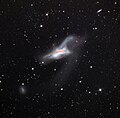NGC 520
| Galaxie NGC 520 | |
|---|---|
 | |
| Das Galaxienpaar NGC 520 aufgenommen vom Hubble-Weltraumteleskop | |
| AladinLite | |
| Sternbild | Fische |
| Position Äquinoktium: J2000.0, Epoche: J2000.0 | |
| Rektaszension | 01h 24m 35,1s[1] |
| Deklination | +03° 47′ 33″[1] |
| Erscheinungsbild | |
| Morphologischer Typ | Pec;HII Sbrst[1] |
| Helligkeit (visuell) | 11,3 mag[2] |
| Helligkeit (B-Band) | 12,2 mag[2] |
| Winkelausdehnung | 3,4′ × 1,7′[2] |
| Positionswinkel | 130°[2] |
| Flächenhelligkeit | 13,1 mag/arcmin²[2] |
| Physikalische Daten | |
| Zugehörigkeit | LGG 20[1][3] |
| Rotverschiebung | 0,007609 ± 0,000010[1] |
| Radialgeschwindigkeit | (2281 ± 3) km/s[1] |
| Hubbledistanz H0 = 73 km/(s • Mpc) | (105 ± 8) · 106 Lj (32,2 ± 2,3) Mpc [1] |
| Durchmesser | 105.000 Lj[4] |
| Geschichte | |
| Entdeckung | William Herschel |
| Entdeckungsdatum | 13. Dezember 1784 |
| Katalogbezeichnungen | |
| NGC 520 • UGC 966 • PGC 5193 • CGCG 411-050 • MCG +01-04-052 • IRAS 01219+0331 • 2MASX J01243507+0347326 • Arp 157 • VV 231 • GC 303 • H III 253 • h 116 • KCPG 31B | |
NGC 520 = Arp 157 ist ein kollidierendes Galaxienpaar im Sternbild Fische und ist etwa 105 Millionen Lichtjahre von der Milchstraße entfernt. Halton Arp gliederte seinen Katalog ungewöhnlicher Galaxien nach rein morphologischen Kriterien in Gruppen. Diese Galaxie gehört zu der Klasse Galaxien mit innerer Absorption.
Die Galaxie NGC 520 wurde am 13. Dezember 1784 von dem deutsch-britischen Astronomen William Herschel entdeckt.[5]
- Panoramaaufnahme mithilfe eines 80 cm durchmessenden Teleskops
- Aufnahme mithilfe des Víctor M. Blanco Telescope
Literatur
- König, Michael & Binnewies, Stefan (2019): Bildatlas der Galaxien: Die Astrophysik hinter den Astrofotografien, Stuttgart: Kosmos, S. 217
Weblinks
- The Colliding Galaxies of NGC 520 – Astronomy Picture of the Day vom 12. September 2005 (englisch).
- Capella Observatory
- CDS Portal
- Seligman Arp
- ARP ATLAS OF PECULIAR GALAXIES
- GoBlack
Literatur
- Jeff Kanipe und Dennis Webb: The Arp Atlas of Peculiar Galaxies – A Chronicle and Observer´s Guide, Richmond 2006, ISBN 978-0-943396-76-7
Einzelnachweise
Auf dieser Seite verwendete Medien
NGC 520 is the product of a collision between two disk galaxies that started 300 million years ago. It exemplifies the middle stages of the merging process: the disks of the parent galaxies have merged together, but the nuclei have not yet coalesced. It features an odd-looking tail of stars and a prominent dust lane that runs diagonally across the center of the image and obscures the galaxy. NGC 520 is one of the brightest galaxy pairs on the sky, and can be observed with a small telescope toward the constellation of Pisces, the Fish, having the appearance of a comet. It is about 100 million light-years away and about 100,000 light-years across. The galaxy pair is included in Arp's catalog of peculiar galaxies as Arp 157.
This image is part of a large collection of 59 images of merging galaxies taken by the Hubble Space Telescope and released on the occasion of its 18th anniversary on 24th April 2008.
| About the object | |
|---|---|
| Object name | NGC 520, Arp 157, VV 231, KPG 031 |
| Object description | Interacting Galaxies |
| Position (J2000) | 01 24 35.42 +03 47 55.0 |
| Constellation | Pisces |
| Distance | 100 million light-years (50 million parsecs) |
| About the data | |
| Data description | The Hubble image was created using HST data from proposal 9735: B. Whitmore (STScI) |
| Instrument | ACS/WFC |
| Exposure date(s) | October 22, 2004 |
| Exposure time | 77 minutes |
| Filters | F435W (B), F555W (V), and F814W (I) |
Autor/Urheber: CTIO/NOIRLab/DOE/NSF/AURA Acknowledgments: PI: J. Moustakas (Siena College) Image Procesing: T.A. Rector (University of Alaska Anchorage/NSF’s NOIRLab) & M. Zamani (NSF’s NOIRLab) & D. de Martin (NSF’s NOIRLab), Lizenz: CC BY 4.0
A galactic collision of two galaxies which began more than 300 million years ago, NGC 520 is actually made up of two disk galaxies which will eventually merge together to form one larger, more massive system. NGC 520 was discovered by William Herschel in 1784 and is one of the largest and brightest galaxies in the Siena Galaxy Atlas.




